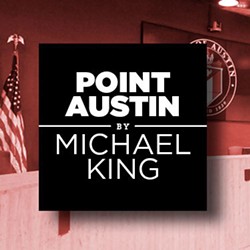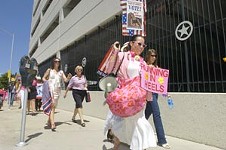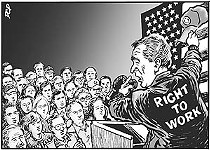Point Austin: Did You Work Last Weekend?
Reflections on the value of Texas labor
By Michael King, Fri., Sept. 11, 2009

So it's hardly a coincidence that as of last year, according to the U.S. Bureau of Labor Statistics, only 5.7% of Texas workers belonged to a union. Readers of our daily newspaper might find it helpful to reflect on these matters the next time the Statesman editors get all red-faced about the powerful unions controlling City Hall. They did manage to note grudgingly that union members – police, firefighters, EMS, and organized workers in all city departments – were largely responsible for balancing this year's city budget, by giving up negotiated or expected raises (although the editors can hardly be trusted to remember that next year). At the annual AFL-CIO fish fry Friday, Mayor Lee Leffingwell reminded the crowd that unions are "the people who brought us weekends." Leffingwell – an American Federation of State, County and Municipal Employees member – might also have noted these were the people who successfully bird-dogged city management to restrain the personnel axe in the annual budget deficit two-step.
The relative weakness of unions in Texas shows up in other ways. The wages of state manufacturing production workers rank 46th in the nation; by contrast, those of government employees (more likely to be organized) rank 28th – not spectacular, but at least nearer the national median. It's worth noting that both restrictive state law and political pressure make it difficult for unions to grow in Texas – by a "good business climate," public officials mean they've managed to keep wages down and workers unorganized.
Winners and Losers
It's not a great year to be celebrating working life. Last week, the BLS noted that the national unemployment rate has reached 9.7%, an increase of 4.8% since the recession officially began in December 2007 (the current state rate is reported at 7.9%). Roughly 15 million people were officially unemployed in August, twice as many as when the recession began. And the official unemployment rate notoriously undercounts discouraged workers and the underemployed; what sort of an economy is it in which more than 10% of eligible adult workers cannot find jobs at all?
That's not to say every Texan is doing poorly. As of 2008, the richest 20% of Texas families had average incomes 7.9 times larger than the poorest 20%. That was the ninth highest gap nationally, and it's growing; in the late Eighties, the Texas wealthy were only doing seven times as well as the poor.
No doubt they would say they are working seven times as hard, too. And 2.8 times harder than the middle 20% (2.3 in the Eighties), the fifth highest gap nationally. Good to know our betters are doing so well. That also couldn't have anything to do with the legalized weakness of organized labor in Texas.
Assuming Responsibility
I'm finding most of these fascinating facts in "Texas on the Brink," the fourth edition (January 2009) of a report issued by the office of El Paso Sen. Eliot Shapleigh compiling various national statistics on the ranking of Texas among the 50 states. A similar report ("Texas: Where We Stand") was once annually produced by the state comptroller, but apparently the incumbent, Susan Combs, got tired of that job a few years ago – it's understandably annoying to see all those dismal comparisons repeated in the newspapers. So Shapleigh and his staff assumed the responsibility, not coincidentally because the senator speaks for the largely impoverished border region. His intro notes: "Texas has the highest percentage of uninsured children in the nation. Texas is dead last in the percentage of residents with their high school diploma and near last in SAT scores. Texas now has America's dirtiest air. If we do not change course, for the first time in our history, the Texas generation of tomorrow will be less prosperous than the generation of today."
It's in this constricted context that the national debate rages on health care reform. Last week, Gov. Perry told a group of Lubbock health insurance agents that Texas can take care of its own. "Cutting into a state's ability to apply local fixes to local problems stifles the sort of innovative solutions that states are best suited to develop," said Perry. Innovative state solutions: That must be why Texas is No. 1 in the percentage of the population that is uninsured (25%, or 5.7 million people), 42nd in Medicaid coverage, and 46th in the percentage covered by employer-based health insurance. One of the governor's "local fixes" for El Paso, noted Shapleigh, is that as of Sept. 1, because of budget cuts, about one in three residents with significant mental health problems – from bipolar disorder to schizophrenia – will no longer receive public care. When those folks inevitably end up in emergency rooms, prisons, or the morgue – underwritten in each case by taxpayers – we can thank the governor and his party for their "fiscal discipline."
Such are just some of the collateral advantages of living in a low wage, low benefits, limited government, weak union state. But if you are lucky, at least you enjoyed your weekend.
Download the fourth edition of “Texas on the Brink” and two reports from the Center for Public Policy Priorities: “Poverty 101” and “Labor Day Update: Texas Unemployment Insurance System.”
Got something to say on the subject? Send a letter to the editor.










